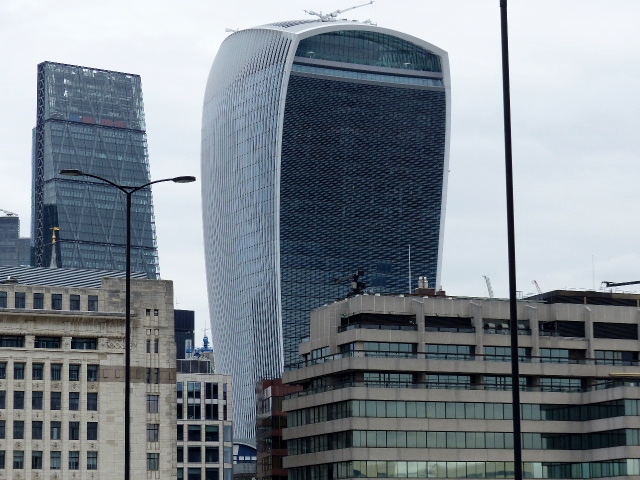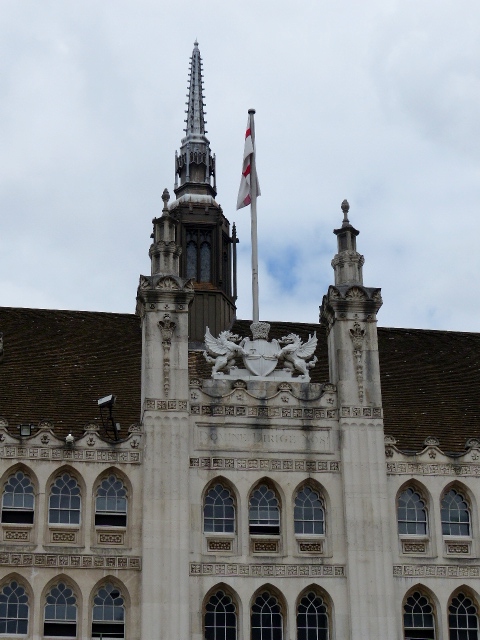The Church of St Magnus the Martyr was, like the rest, closed when I and many other tourists passed by. This was rather unfortunate as with many tourists it could have brought in cas...been helpful for the church and in a position to speak of the history of the church and the role it had in London in times past. For one thing outside the front door the roadway once led on to London Bridge as was and many a foot has trod this way before. This was an important church in the past. Today 'Adelaide House' another money machine this time for lawyers, engulfs the surroundings making it difficult for the church to breathe.
Not a great picture but with the church door to the left as you pass through you get some idea of times past and the throng that once used this path daily. The first stone bridge was built in 1209 (that's A.D., not a.m. by the way) and the bridge existed on this alignment until 1831. Arguments rage over who St Magnus was as several contenders could be the one. It is best to let them argue and look at what lies around.
The Romans built the wharf here early on and Londinum sent a Bishop to the Council of Arles in 314 and some like to think this church existed then. It certainly did in the 1100's and was rebuilt by Christopher Wren at a cost of nearly ten thousand pounds after it was destroyed during the Great Fire. It was an important church partly because of the position and that possibly encouraged greater spending on a rebuild. Fishermen had their shops just to the south of the church along the riverside and as such the church became the Guild church of the 'Worshipful Company of Fishmongers.' Billingsgate Fish Market used to stand right behind the back end of the church, today two tallish buildings fill the space. Evidence for the Roman wharf was found in 1931 close to the church and this blackened portion of timber piling is now stationed outside the church door. This dates from the year 75.
The River Thames still carries a lot of traffic however much of it now appears to be tourist boats staffed by chaps touting for tips it seems to me. In 1966 when employed at my first job of work I scribbled out paperwork for lorries carrying a thousand cases of whisky to London Docks headed for various parts of the world. At that time both sides of the river before Tower Bridge would be lined with tramp steamers while cheery cockney dockers pinched as much as they could from each consignment. Working on the docks was a poor show, each man having to be called out from the crowd of jobseekers by the foreman every morning and work was not guaranteed. Constant strikes, sometimes these were understandable, did not encourage sympathy for the East End men. It was in 1966 I saw the first containers being put to use and it was interesting to note that all 1000 cases of whisky reached their destination unopened, something that did not always happen otherwise. We used Southampton, Liverpool and Glasgow docks but the British Road Services drivers disliked London most of all which tells you something. The opening of new docks with few workers at Felixstowe and elsewhere killed such docks and now they contain expensive flats and tourist sights. The barges today may well have a variety of uses but I know that much of London's sewage gets carted away in similar barges to landfill sites further down towards Kent. In the past many were used to unload ships that could not get docked at the Port.
What mean you 'That's boring?'
In itself it contains much that is boring but it does represent all those steps that once were arrayed along the Thames enabling those using the River Taxi's to cross from one side to the other. Those little rowing boats plied their trade for centuries until in the 19th century they decided to build more bridges. Much trouble ensued as the 'Taxi' drivers lost their income and folks walked across for nothing, there again who has ever met a happy taxi driver? The river was crisscrossed by such taxi's while sail and steam boats and many other craft made their way up and down stream. It is no surprise that on occasion there were accidents especially in the recurrent smog.
In the far distance squashed in amongst other buildings stands the Tower of London. This was begun not long after William the Conquerer took over and the Keep, the 'White Tower' in the middle went up in 1078. Since then the fortification has seen several changes but basically the tower itself stands as Willie built it. Once it towered over London in similar fashion to his Barons wooden, then stone, castles towered over the rest of the population. The resentment felt by the locals was palatable, especially in London a place which has never been keen on outsiders telling it what to do. Willie and his men had a good way of dealing with rebels, they slaughtered them, that kept them in the their place somewhat. Today the Tower appears a little squashed but no vast skyscrapers are built too close I notice.
Had I the energy I would have wandered around to see the ancient ship stuck away permanently in the far dock. I did see it up close about 25 years ago but I suspect the area around is now full of the cafes' and eateries that abound in tourist traps. That tourist boat looks gey full to me, I suspect it is a tourist boat but could be a special party. Later I learned some of those folks who row kayaks around the UK or the world were returning home and some boats were heading out to welcome them. Row around the UK? Are they daft?
This rather gentle Art Deco style office block is Adelaide House, the building that engulfs St Magnus. The building was one of the first to be steel framed and covered with very expensive Portland Stone and when erected became the highest office block in the City of London. The name comes from King William the IVs wife Adelaide, this because she opened the new London Bridge in 1831. She didn't see this building however it arrived in 1925.
On the front stands this lass holding a globe for reasons not stated. She stands on a coat of arms from an Australian state, several line the front for reasons unknown. If you wish to know why ask one William Reid Dick who chiselled her out and he will explain, although he may be dead by now.
What's that doing here?
Nothing. However after wandering around London the heart cries out for greenery and plant life.





















































